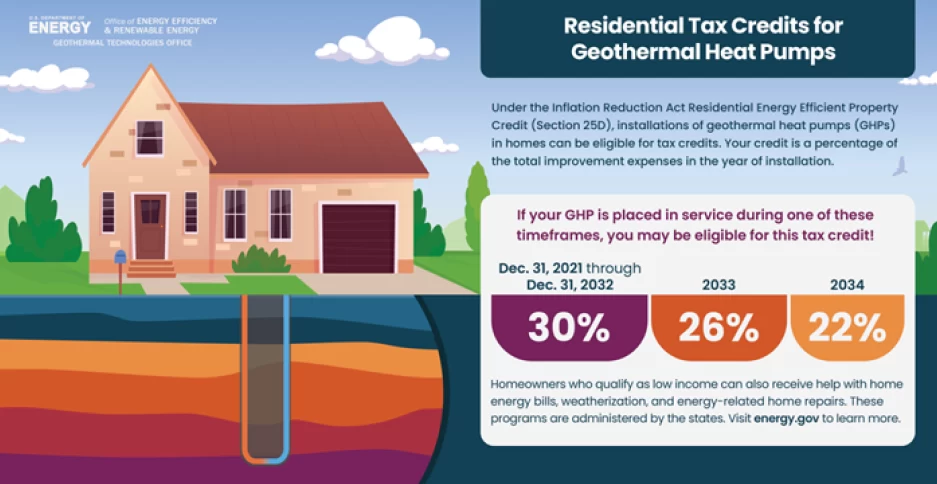Geothermal HVAC is an energy efficient, low-cost solution to keep your home comfortable year-round.
Are you ready to say goodbye to dirty fossil fuels and inefficient air conditioning systems? Discover the benefits of using geothermal energy to heat and cool your home.
Geothermal uses a heat pump to leverage consistent underground temperatures. Beneath the surface of the earth, temperatures remain remarkably stable, typically ranging from 40°F to 70°F, regardless of the season. Geothermal heating and cooling harnesses this steady underground temperature to provide efficient heating during winter and cooling during summer.
While above-ground temperatures can swing wildly—from icy winters to sweltering summers—the ground just a few feet down stays consistently temperate. By transferring heat between your home and the earth using a ground heat exchanger, Geothermal Heat Pumps create a reliable, energy-efficient way to maintain indoor comfort all year long.
A geothermal heating and cooling system has several key parts: the heat pump, the air handler, the ground loop, and the distribution system. These pieces work together to heat and cool your home efficiently and cost-effectively.
Our Direct Exchange (DX) geothermal systems bypass the need for water-based ground loops, instead using refrigerant in copper pipes buried underground. This direct thermal exchange process enhances efficiency and eliminates the intermediate step of transferring heat through a liquid solution.
The indoor unit is the system’s “brain.” It contains the compressor, heat exchanger, air handler, and electronic controls. Unlike standard heat pumps, it gets energy from the stable temperatures underground instead of the changing outdoor air.
The ground loop circulates refrigerant through underground copper pipes. This refrigerant absorbs or releases heat from the Earth. The type of loop depends on your land and geology:
Vertical loops work best with Direct Exchange systems.
After the system absorbs or delivers heat, your indoor air handler spreads warmth or cooling through your home’s ductwork. Many geothermal systems can connect to existing ductwork, making retrofitting older homes possible. However, we can also install new ductwork in your home.
When heating your home, a geothermal system leverages the stable underground temperatures to provide warmth efficiently:
The ground loop circulates refrigerant through the Earth, where it absorbs heat from the ground.
The heat pump pulls the heat from the ground loop’s refrigerant and compresses it, raising its temperature. This heat is then transferred to your home’s air or water-based heating system through the heat exchanger.
Once heated, the warm air or water is circulated by the air handler through your home via the ductwork, ensuring every room stays cozy.
Geothermal heating eliminates the need to burn fossil fuels, offering a cleaner, more energy-efficient way to stay warm during winter.
In cooling mode, the geothermal system reverses the process to cool your home:
The heat pump extracts heat from the air inside your home using the refrigerant system. This heat is transferred to the refrigerant circulating in the ground loop.
The ground loop carries the absorbed heat and releases it into the cooler underground environment.
The heat pump cools the air and the air handler sends it through your home’s ductwork, keeping the indoor environment comfortable and refreshing.
Geothermal cooling not only reduces electricity costs but also avoids the noise and maintenance of traditional outdoor condenser units, offering a quieter and more sustainable cooling solution.
With tax incentives from the federal government and New York State, as well as rebates from your local energy provider, you can significantly reduce your cost to switch your property to Geothermal.
30% of total cost (uncapped)
25% of total cost (up to $5,000)
$25K to $35K

The cost of a Direct Exchange Geothermal Heat Pump System varies depending on the size of the unit needed for your home. The total cost of a system is typically between $85,000 to $150,000.
However, that cost can be significantly reduced by tax incentives and credits in New York State, at times making it cheaper than a traditional HVAC system. There are also significant cost savings over the life of your system due to lower energy costs.
The best way to get an accurate price is to Start a Conversation and we’ll visit your property in-person to give you a free detailed estimate.
The ground loop component of your Geothermal System will typically last at least 50 years, usually more. The heat pump component lasts on average longer than a traditional air exchange heat pump.
The various components of your Geothermal HVAC System are each covered under an individual warranty. Please speak with us about the specific system you select, and we will ensure that you fully understand your warranty coverage. Here are a few of the warranties that typically come with the various components of your system.
Geothermal Unit: 2 year warranty on parts and labor, with a 5 year warranty on compressors
Air Handler: 10 years parts limited warranty. Owner must register equipment with manufacturer.
Copper Loops: 20 year limited parts warranty/2 year labor warranty
On average the actual installation of your system takes about 2-3 weeks. This can vary depending on your property.